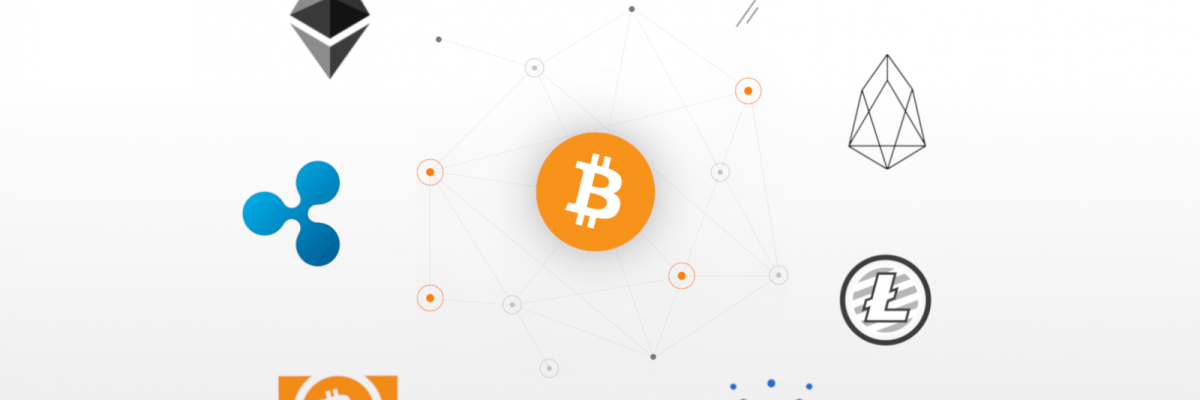After the rapid growth of the cryptocurrency market in December of 2017, it was time for prices to correct, experienced industry participants to take profit, and newcomers to panic. Despite contradictory...
After the rapid growth of the cryptocurrency market in December of 2017, it was time for prices to correct, experienced industry participants to take profit, and newcomers to panic. Despite contradictory forecasts of various experts, the cryptocurrency market is continuing to develop. New cryptocurrencies have appeared. Some of them offer highly specialized solutions, others - the global development of the industry.
The aggregator, Coinmarketcap, already tracks data on 1,639 cryptocurrencies on 400 different exchanges.
In this review are the top ten cryptocurrencies in terms of market capitalization in the beginning of the summer of 2018.
1. Bitcoin (BTC) - the main cryptocurrency
Bitcoin still remains the main cryptocurrency: it is about 40% of the total market capitalization. Its dominance is perhaps largely due to the fact that Bitcoin was the first independent decentralized payment cryptosystem.
The creator of Bitcoin is Satoshi Nakamoto. Behind this pseudonym lies the developer (and maybe several programmers), who still remains incognito.
In 2008, Satoshi published an article describing the principles of the operation of the Bitcoin network. BTC's supply is limited to 21 million coins, 17 million of which have been produced so far.
The Bitcoin network is peer-to-peer. That is, transfers are made directly between the two participants, without the intervention of a third party. With normal bank transfers banks act as guarantors, confirming that the sender no longer has the transfer amount and that the recipient has collected the money. With Bitcoin, the network performs this function itself.
The network's transactions are relatively anonymous: when you transfer funds the sender's data is not transferred, but the record of the transaction is included on the public blockchain. Unlike classical payment systems like Visa or Mastercard, you can not cancel a transaction with Bitcoin.
Cryptographic protection of wallets makes it impossible to hack them directly. Many users appreciate the security of cryptocurrencies.
Despite the fact that BTC dominates the market, the main cryptocurrency has its drawbacks. First, it has a rather low transaction speed. Because of this Bitcoin is used less often for small purchases. In addition, BTC has a strong volatility in the exchange rate, which affects the entire market.
Market capitalization of Bitcoin is about $130 billion and the daily volume is about $5 billion.
2. Ethereum (ETH) – a platform for blockchain applications
Ethereum is often called the main rival to Bitcoin in the cryptoworld. ETH is simultaneously a cryptocurrency and a platform on the basis of which it is possible to issue a token, set up a decentralized application, or even create a new ecosystem on the blockchain.
The project's founders, Vitalik Buterin, Gavin Wood, and Joseph Lubin, collected 31,191 BTC (more than $18 million) for the launch of the project in 2014 with the help of crowdfunding. Ethereum was first released in 2015.
The Ethereum network operates on the principle of a decentralized virtual machine. At the heart of Ethereum's work are smart contracts - algorithms that ensure the execution of operations on the blockchain only when certain conditions are met.
Another distinguishing feature of Ethereum is an unlimited issuance of coins. The community is discussing the possible introduction of a technology for "burning" used ETH.
Currently, for each block found miners receive a reward of 5 ETH. Network blocks are generated much faster than in Bitcoin - just 15 seconds.
Ethereum has a much greater centralization than with Bitcoin and the and the price is strongly influenced by the success of developers.
Joseph Lubin believes that Ethereum has a huge potential to be "a programmable money."
The market capitalization of Ethereum is more than $60 billion and the daily volume is about $1.8 billion.
3. Ripple (XRP) – a payment ecosystem
The Ripple cryptocurrency system is designed for instant currency settlements. Calculations are made within the network using the XRP token. Ripple does not have a blockchain and users do not engage in mining. The developers released a fixed number of coins all at once - 100 billion. Currently, 39 billion XRP's are in circulation and the rest - 61 billion - are reserved for use in the future.
The Ripple system is similar to thestructure of the SWIFT bank transfer network. The money that users send using the Ripple system is converted to XRP on the sender's side and then back to the selected currency on the recipient's side.
One of the main advantages of Ripple is the cooperation with banks and businesses. In addition, XRP has a high transaction speed and a relatively stable price. Unlike many other cryptocurrencies, it is possible to cancel transactions using Ripple,
The creators of Ripple believe that XRP is a much faster and more reliable alternative to other cryptocurrencies.
The total market capitalization of Ripple on CoinMarketCap is about $26 billion and the daily volume is about $500 million.
4. Bitcoin Cash (BCH) – an alternative Bitcoin
Bitcoin Cash is a fork of Bitcoin which gained great popularity and became an independent cryptocurrency. On different exchanges it is sometimes designated BCC or BCH.
The fork of the blockchain occurred on August 1st, 2017 as a result of a long dispute with the community over the outdated Bitcoin code. Transactions on the original network had become slow due to the 1 megabyte block size limitation and the transaction fees had increased significantly. The developers decided to create a new chain with a block size of 8 megabytes.
The coin quickly grew in price thanks to the wide support from the community.
The market capitalization of Bitcoin Cash is about $20 billion and the daily volume is almost $1 billion.
5. EOS (EOS) – a scalable blockchain for decentralized applications
The EOS platform, like Ethereum, allows you to create decentralized applications and set up smart contracts. The developers are focused on the speed and scalability of solutions based on EOS.
Confirmation of transactions in the EOS network is based on the principle of Proof-of-Stake. To approve an operation, the most significant network nodes with a large volume of cryptocurrency in the wallets are selected. This approach significantly increases the speed of transfers, but it makes the network more centralized: about half of all tokens are controlled by only ten addresses.
The project has a lot of critics who note that among the shortcomings of EOS is very poor documentation and the lack of a finished product or a formal report to investors.
However, EOS is very successful. Chief developer Dan Larimer is known in the cryptocurrency world and provides confidence to investors. It is much more convenient to conduct an ICO based on EOS rather than Ethereum. Compensation in tokens for developers is distributed for 10 years. This gives an additional incentive for the development of the platform. Another important advantage is the speed of transactions (up to 50,000 transactions per second), which is higher than the Bitcoin and Etherium networks. Also, EOS outperforms the VISA payment system in terms of speed.
The market capitalization of EOS is more than $12 billion and the daily volume is $1.5 billion.
6. Litecoin (LTC) – a lightweight and improved Bitcoin
Litecoin – the second in the history of Bitcoin forks. The project's founder, Charlie Lee, became interested in cryptocurrencies when he worked as a developer at Google. He decided to create a new cryptocurrency based on Bitcoin's program code.
The main advantages of Litecoin are almost zero transaction fees and the speed of data processing.
With Litecoin, the transaction confirmation time has been significantly reduced and the data on the blockchain is stored more efficiently.
Mining Litecoin is more profitable than mining BTC. The total number of coins has been increased to 84 million.
The market capitalization of Litecoin is $7 billion and the daily volume is more than $300 million.
7. Cardano (ADA) – a third-generation cryptocurrency
Cardano is a new cryptographic platform written using the Haskell programming language, which allows you to quickly and cheaply create decentralized applications and smart contracts.
Thanks to an improved approach to application scalability and security, Cardano is called a third-generation cryptocurrency. The first generation includes cryptocurrencies like Bitcoin and Litecoin, and the second generation are platforms on which you can create new products (for example Ethereum). Thus, Cardano is a more perfect blockchain-platform - a direct competitor to Ethereum.
One of the developers of Ethereum, Charles Hoskinson, having participated in the key stages of the development of ETH decided to create the perfect blockchain for scalable applications. This idea attracted other developers who joined the Cardano team. The project was completely created from the ground up at the end of 2014, and in 2015 the first release appeared. The development of the project is supported by IOHK, Emurgo, and the Cardano Foundation.
95% of the total amount raised during the ICO was made by Japanese investors, so Cardano is sometimes jokingly called the Ethereum of Japan.
The market capitalization of Cardano is $5.6 billion. The daily volume is $117 million.
8. Stellar (XLM) - a universal infrastructure for money transfers
Stellar's cryptocurrency allows companies, financial institutions, and ordinary users to make money transfers in real time. In 2014, Jed McCaleb and Joyce Kim created their own payment system based on Ripple because they believed that the management of Ripple Labs used the system for personal gain. In addition, the XRP network is strongly centralized and all tokens belong to the company.
The developers of Stellar created a Ripple clone, devoid of defects. The related platforms immediately became strong competitors.
On May 22nd, 2014, Jed McCaleb announced the sale of his assets in XRP. This led to a drop in theprice of Ripple by more than 40%. After a lengthy trial between McCaleb and Ripple, the parties entered into a restrictive agreement which froze McCaleb's accounts including $40.5 million in XRP.
The Stellar Foundation (Stellar Development Foundation) is developing the platform. The token was originally called stellar, after a star. The modern name is lumen (XLM).
All code must be open-sourced under the rules of the platform. There are no privileged users. All of the activities of the developers are carefully documented and published in the form of reports. Additional rules apply to the distribution of coins. Initially, the company issued 100 billion tokens. 5% is spent on operating expenses and fund development. 25% is transferred to non-profit organizations. Every year, inflation is artificially created at 1%.
Total market capitalization is $5.5 billion and the daily volume is more than $60 million.
9. TRON (TRX) – a killer of paid services
The cryptocurrency TRON appeared in September of 2017. The Chinese start-up company decided to create a new cryptographic platform that would become a "killer of paid services" such as Google Play or the App Store. TRON's advantage is in its free access to such resources.
The price of TRON went up sharply after the developers reported on their success in platform development. In addition, TRON has entered into a partnership with the Gifto blockchain platform to handle the monetization of decentralized content.
The goal of TRON is to create a global entertainment platform based on blockchain. The platform allows you to create social networks, games, online casinos, etc. thanks to its decentralized organization.
The project solves the problem of access to various content and services of digital entertainment thanks to the concept of the distributed economy.
Market capitalization is almost $4 billion and the daily volume is $235 million.
10. NEO (NEO) – a transition to a smart economy
NEO is another alternative to Ethereum. Because of the many similar characteristics, it is sometimes called the "Chinese Ethereum". NEO also uses smart contracts, which, according to the developers, are more advanced and free of many of their competitor's vulnerabilities. For NEO smart contracts use the Solidity language, as in the case of Ethereum.
The Chinese company OnChain began developing the Antshares (ANS) platform in 2014, the first version was released on October 17th, 2016. After rebranding the platform received a modern name.
NEO has a public blockchain but all of the network nodes are controlled by OnChain. The number of NEO tokens is limited to 100 million. There are now 65 million in circulation. Developers produce another 15 million coins annually.
The tokens are equally distributed between investors and developers. Of the 10% of the NEO's received by pre-ICO participants, 17% were allocated for the first ICO, 23% for the second ICO.
Market capitalization is about $3.5 billionand the daily volume is almost $90 million.
Share this with your friends!






Be the first to comment
Please log in to comment